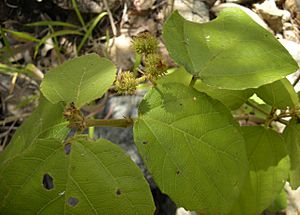Mallotus ficifolius facts for kids
Quick facts for kids Mallotus ficifolius |
|
|---|---|
 |
|
| Mallotus ficifolius fruit and foliage | |
| Scientific classification | |
| Genus: |
Mallotus (plant)
|
| Species: |
ficifolius
|
| Synonyms | |
|
Echinus claoxyloides var. ficifolia Baill. |
|
The Mallotus ficifolius is a type of shrub. It belongs to the spurge family, which is called Euphorbiaceae by scientists. This plant is special because it only grows in Northern and Central Queensland, Australia. You might hear people call it the fig-leafed mallotus because its leaves look a bit like fig leaves.
Contents
Discovering the Fig-Leafed Mallotus
This plant is a shrub, which means it's smaller than a tree but bigger than a small plant. It's part of a big group of plants known as the spurge family. This family has many different kinds of plants all over the world.
What Makes It Unique?
The Mallotus ficifolius is endemic to Queensland. This means it naturally lives only in that part of Australia and nowhere else. It's a unique plant that helps make the Australian forests special.
Where Does the Fig-Leafed Mallotus Grow?
This shrub likes to live in wet forest areas. It often grows under taller trees, which is why it's called an understorey plant. It's also a pioneer plant. This means it's one of the first plants to grow in an area after a disturbance, like a fire or a storm.
Its Favorite Homes
You can find the Mallotus ficifolius in different types of wet forests. These include rainforests, which are very dense and wet. It also grows in vine scrub and gallery forests. Gallery forests are special forests that grow along rivers and streams.
What Does the Fig-Leafed Mallotus Look Like?
Most of these plants grow to be about 1 to 3 meters tall. That's like being as tall as a grown-up or even a bit taller! They have some very clear features that help you spot them.
Leaves and Flowers
The leaves of the Mallotus ficifolius are wide and covered with tiny hairs. Their edges are not smooth; they have small teeth or jagged parts, like a saw. The flowers are not very noticeable. They are small and yellow, blending in with the plant.
Fruit and Seeds
The fruit of this plant is round and about 10 millimeters wide. That's about the size of a small pea. Like other plants in the spurge family, its fruit is lobed, meaning it has different sections. The fruit is also covered with rough, spiky bumps, which makes it look interesting!

